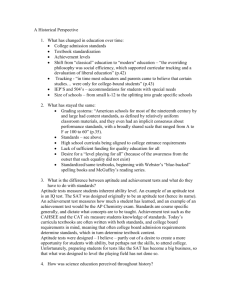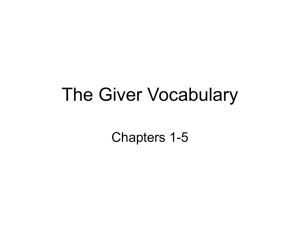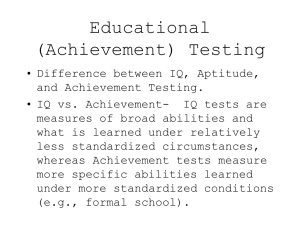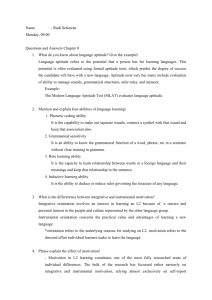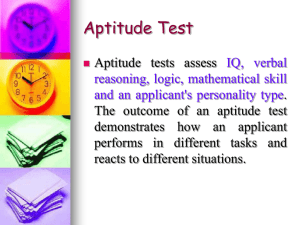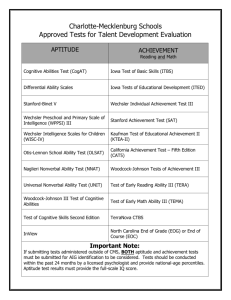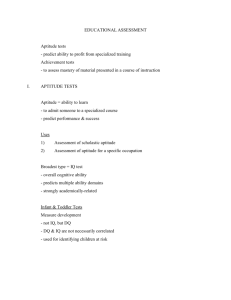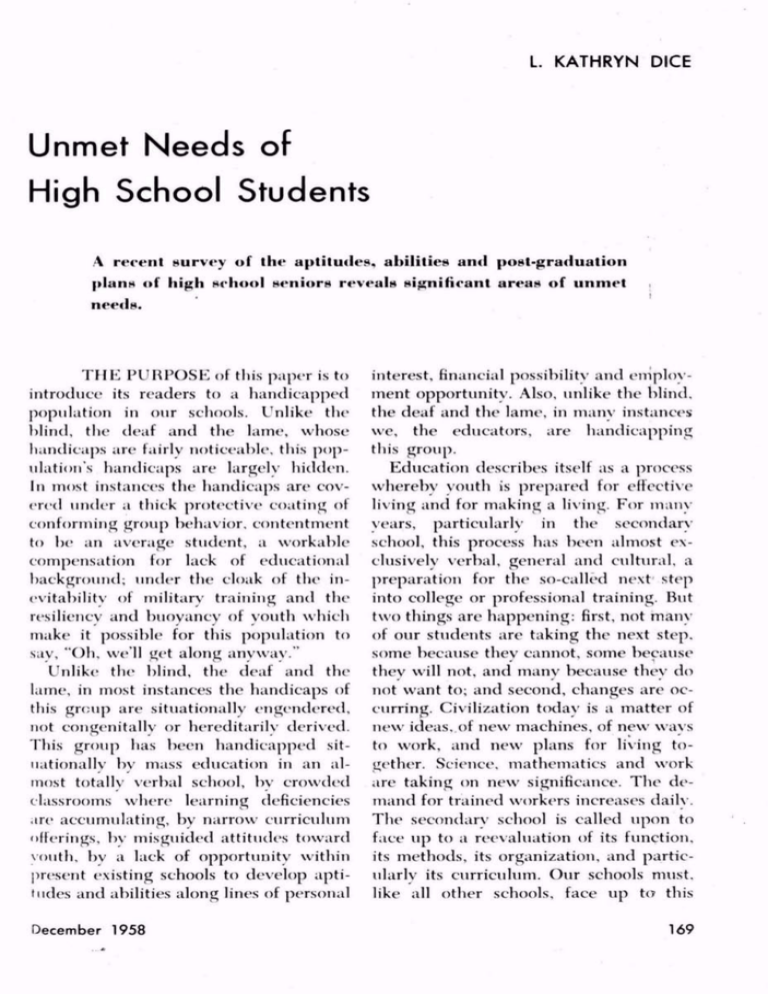
L. KATHRYN DICE
Unmet Needs of
High School Students
A recent survey of the aptitudes, abilities and post-graduation
plans of high school seniors reveals significant areas of unmet
needs.
THE PURPOSE of this paper is to
introduce its readers to a handicapped
population in our schools. Unlike the
blind, the deaf and the lame, whose
handicaps are fairly noticeable, this pop
ulation's handicaps are largely hidden.
In most instances the handicaps are cov
ered under a thick protective coating of
conforming group behavior, contentment
to be an average student, a workable
compensation for lack of educational
background; under the cloak of the in
evitability of military training and the
resiliency and buoyancy of youth which
make it possible for this population to
say, "Oh, we'll get along anyway."
Unlike the blind, the deaf and the
lame, in most instances the handicaps of
this group are situationally engendered,
not congenitally or hereditarily derived.
This group has been handicapped sitnationally by mass education in an al
most totally verbal school, by crowded
classrooms where learning deficiencies
are accumulating, by narrow curriculum
offerings, by misguided attitudes toward
vouth, by a lack of opportunity within
present existing schools to develop apti
tudes and abilities along lines of personal
December 1958
interest, financial possibility and employ
ment opportunity. Also, unlike the blind,
the deaf and the lame, in many instances
we, the educators, are handicapping
this group.
Education describes itself as a process
whereby youth is prepared for effective
living and for making a living. For many
years, particularly in the secondary
school, this process has been almost ex
clusively verbal, general and cultural, a
preparation for the so-called next step
into college or professional training. But
two things are happening: first, not many
of our students are taking the next step,
some because they cannot, some because
they will not, and many because they do
not want to; and second, changes are oc
curring. Civilization today is a matter of
new ideas, of new machines, of new ways
to work, and new plans for living to
gether. Science, mathematics and work
are taking on new significance. The de
mand for trained workers increases daily.
The secondary school is called upon to
face up to a reevaluation of its function,
its methods, its organization, and partic
ularly its curriculum. Our schools must,
like all other schools, face up to this
169
challenge. We must look again to cur
riculum revision in the high schools and
the development of technical schools and
programs for youth with aptitude along
special lines and for whom opportunities
for post-high school training are remote,
if not impossible.
Plan for the Survey
With all this in mind a comprehensive
study of the aptitudes, abilities and posthigh school plans of high school seniors
recently was undertaken. This study was
devised to serve five purposes: first, to
explore through the use of standardized
tests the abilities of high school students
in order to look objectively at the range
of ability and aptitude of those who
would graduate in June 1958, from the
Allegheny County, Pennsylvania, publichigh schools; second, to consider their
educational and work plans in order to
sharpen the perceptions of counselors
and teachers as to the wider significance
of individual differences; third, to relate
observed aptitudes to school plans and
employment opportunities; fourth, to pro
vide statistical data based not on a popu
lation in California, Kansas, or New York,
but based on a real live population of
our own adolescents in our own schools,
to support the need for extending the
offering of the secondary schools to in
clude technical types of education; and
fifth, to indicate areas, should such
emerge, in which secondary education as
a whole may need improvement.
Now, may I give you just a very brief
description of the experimental setup?
After a very exhaustive study of the liter
ature on aptitude testing and a study of
the manuals of aptitude tests, particularly
L. KJTHRYN DICE i* director, Bureau
of Special Pupil Service*, Department
of Public Instruction, Harrisburg, Penn
sylvania,
170
as to their reliability and validity, and
after a study of the local opportunities
for employment and job finding in this
area, a test battery was set up. This took
three hours to administer and tested apti
tudes in five general areas of aptitude
which we believe to be significant for the
youth of Allegheny County. Included in
this battery were tests designed to meas
ure scientific aptitude, as related to such
courses as laboratory technician and
nursing; artistic aptitude, as related to
such courses as cosmetology for girls, de
sign and construction for boys; verbal
aptitude, as related to the application of
learned principles to specific problems;
clerical aptitude looking toward a better
type of preparation for the students who
go into the world of business; engineer
ing aptitude, as related to the skilled and
semi-skilled trades.
Fourteen high schools agreed to partic
ipate in this study and the students who
participated were selected completely at
random. There was no attempt to stack
the cards either in favor of the good stu
dent or the poor student, in favor of the
academic student or the commercial stu
dent or the vocational student. The four
teen participating high schools were
asked to submit an alphabetical list of
the names of the students who were
graduating from high school in June
1958. Every fifth name on these lists was
selected to participate. Thus, the students
who are in this study are included on this
random sampling basis by accident of
initial of their surname. One high school
in which the tests were scheduled to be
administered in April and early May de
cided to withdraw from the study. There
fore the following data cover only 13
schools.
The groups tested were made up of
433 seniors graduating from 13 high
schools in a one-quarter segment of AlleEducational Leadership
gheny County. They were between the meet Helen and consider with me the
ages of seventeen years, one month and profile of her test scores. She is an aca
twenty years, ten months. They were demic student in a large high school and
one of the eight students in the total 433
generally physically fit about 20 per
cent wore glasses, two said they had who rated herself above average. She
hearing losses, one said he had a cardiac has just passed her seventeenth birthday,
condition, and one had an artificial limb. is slight in build, well dressed, well
In most instances they were bright young groomed, an easy conversationalist, a fine
people. They were well dressed, they type of teen-ager, is popular with both
were conforming, they were pleased with boys and girls of her age group, and
physically strong. She is an only child.
themselves; they were eager to partici
pate, full of life, and ready to talk about Her mother is a widow and she
life. They were ambitious in some cases, and Helen share a small apartment.
they were frustrated in many cases; they Her mother is employed as a secretary.
were uncertain about the future; they This mother and daughter read arid play
were seeking guidance. Some of them together and make many plans for
were able to blame their parents and Helen's adult life. Helen would like to go
their teachers, many of them were able to college but she knows it will be a
to blame themselves. They were hunting financial struggle. She wants to be a so
answers to burning questions; they made cial worker, a teacher or a nurse. Her
up a good cross section of teen-agers as test results show that she has aptitude in
any area and could follow academic
we know them today. They were to grad
uate from prescribed courses. They had pursuits or technical pursuits and be suc
plans, they lacked plans, but they knew cessful in either field. The deciding fac
what they would have liked to do if the tors for students like Helen should be
their own personal interests. High schools
facilities had been available, if the atti
tudes had been right, and if there had would be different if all students were
like Helen!
been greater freedom of choices.
Now meet George, who is in an aca
The tests administered to these 433
students fell in three general areas. There demic course with average and belowwere ability tests, both of verbal and average grades. He cannot spell aca
nonverbal general intelligence; tests of demic, "a-c-m-e-d-i-c-k." He has repeated
three grades and is now nineteen and a
aptitude in five areas, mentioned pre
viously; and tests of previous learning in half years of age. He is out of step with
terms of arithmetic and reading skills. his parents and with his teachers. His test
Each student completed a questionnaire scores show that he is high in terms of
in which he described himself and rated ability but low in terms of achievement,
himself as to his use of his abilities in the with little or no aptitude in any specific
field. George wants to be an electronics
preceding years of school and gave a de
scription of his future plans for further engineer or, surprisingly, a high school
education and choices of jobs and pro- English teacher.
And so it goes. Each student has his
lessional opportunities.
own constellation of ability and disabil
Two Contrasts
ity; each student has a need for guidance
Now I want you to meet two of the along lines of his own; many students
433 and know them intimately. First need new courses, new direction, new
December 1958
171
3. That 71 of these students showed,
on selected tests, average and belowaverage ability academically but have
Results of the Study
technical or vocational aptitude at the
All of the 433 students in this group skilled trades level;
now have high school diplomas. They
4. That 28 of these students showed,
vary widely. Test results indicate that the on selected tests, ability only at the semi
lowest verbal IQ was 72 and the highest skilled trades level;
was 159. One asks at once, if the high
5. That 29 of these students showed
school met adequately the needs of the exclusively verbal aptitude. This finding
student with the IQ of 72, what happened should be emblazoned in letters of red
to the student with an IQ of 159, and for it shows that of this total group of
vice versa? Eleven of these students had students graduating, to a large degree,
verbal IQ's of less than 90; 252 had from courses exclusively verbal, only
verbal IQ's between 90 and 110; and 120 seven percent are exclusively verbal stu
had verbal IQ's from 110 to 160. This is dents by aptitude!
6. That 26 of these students show no
most startling when one recalls that only
eight of the group rated themselves aptitude along technical, vocational or
above average in high school grades.
academic lines.
As we move into this technological age,
There are data, also, to indicate that
we can no longer be content to measure this group is not only handicapped by
ability in terms of verbal IQ alone. limited opportunity to elect courses in
Therefore, it is necessary to consider the line of aptitude, but is also handicapped
distribution of nonverbal, or performance in other significant ways the handicaps
IQ's. In this particular study the lowest of unrealized opportunities. Seventy per
nonverbal IQ was 59 and the highest was cent of the 433 students in this study read
164. Seventy-three of these students had below the forty-fifth percentile for
nonverbal IQ's below 90; 256 had non
twelfth grade students. This means that
verbal IQ's between 90 and 110; and 104 three and one-half out of five were read
had nonverbal IQ's between 110 and 165. ing somewhere below the tenth grade
Again, one is impressed by the range of level. Also, 46 percent of these 433 were
ability indicated and the limited oppor
in the same dilemma as far as mathe
tunities in the usual high school to meet matics was concerned. These findings
the needs inherent in this range.
are sobering; they are serious. They cause
The results of this study indicate:
us to stop and reflect on what we have
1. That 83 of these students showed, done with ourselves, but more particu
on selected tests, aptitude to do either larly on what we have done to those
academic or technical work; they are upon whom the doors of the school have
equally capable in both broad areas and already swung shut.
In other academic skills we see still
able to make the choice of a professional
or technical field in the light of personal more signs of unrealized opportunity.
Two of the students in this study could
interests and available opportunities;
2. That 196 of these students showed, not spell correctly the name of the high
on selected tests, outstanding technical school from which they were graduating;
abilities in one or more of the areas in 11 of them spelled incorrectly their dis
trict of residence; 75 of them spelled inwhich we tested;
outlets if their potentials are to be de
veloped and utilized profitably.
172
Educational Leadership
correctly the job which they hoped to
take when they leave school, and in
cluded in this 75 are 3 who said that
they want to be teachers. Forty of them
could not spell the name of the course
from which they were graduating.
Stated in still another way, the find
ings indicate that 18 percent of the 433
could do anything they wanted to aca
demically or technically; 47 percent of
them had special untapped ability in
technical fields; 14 percent should have
been in vocational schools; 7 percent
were exclusively verbal; 7 percent func
tion at a semiskilled level; and 7 percent
showed no aptitude for either academic,
vocational, or technical work. This, too,
is staggering, when we realize that for
a hundred years the high school has ex
isted for the academic student, and it is
further staggering to see how many of
these students might have been much
more profitably spending their time in
some other area of education more suited
to their abilities and more in line with
their personal jjiterests.
Up to this point the reader may be
saying, "Oh, well, they'll go on to college
and college will make up for everything
we haven't given them." In this regard,
consider with me some of the data con
cerning the educational plans of students
with aptitude for academic and technical
pursuits. This represents the three ablest
groups those with aptitude in every
area, those with specific aptitude along
technical lines, and those with exclu
sively verbal aptitudes. Of the 83 stu
dents who have aptitude in every area,
23, or one in four, expect to go to college;
14 of them, or one in five of these ablest
students expect to go into some kind of
post-high school training at the noncollege level comptometer schools, beauty
schools, secretarial schools, schools of
nursing, armed forces; but of this seg
December 1958
ment of our high school population, 46
students, 50 percent or one in two. will
go directly from the door of the high
school to the door of an employer.
In our second ablest group, those stu
dents with outstanding technical ability,
24 percent, or one in four, plan to go to
college; 27 percent to a trade school of
some type; and, again one out of every
two will walk from the school door to
that of employment.
In the group which is exclusively ver
bal, only 13 percent plan to go to college.
Of these, 19 percent plan to go into trade
schools or the armed forces, and 68 per
cent, almost three out of four, will walk
from the school door to that of industry.
Recommendations
This detailed study of the aptitudes,
abilities, and ambitions of 433 students
just about to graduate from our high
schools shows that these young people
are leaving school with many unmet
needs. What are some recommendations
growing out of this survey?
1. \Ve can no longer postpone the
extension of the reading program into
the secondary school. The great amount
of reading retardation indicated here
stresses again the fact that reading in
struction is both an elementary and a
secondary school problem and, therefore,
both an elementary a nd a secondary pro
gram are exceedingly important. The
elementary school makes use of textbooks
and grouping to structure itself -for the
teaching of reading. Children step out of
that atmosphere into an unstructured sit
uation where they are supposed *to per
form independently with skills that are
not yet consolidated. The figures showing
that 70 percent of this group are grad
uating below average in reading skills
call for new approaches to the reading
problem. What is required in the high
173
School is an extension of the develop
mental reading program and not merely
a remedial one.
2. We need the same type of improve'ment in mathematics, again not remedial,
but developmental, in terms of a better
foundation for the scientific and business
careers which are the goals and ultimate
opportunities for many of the students
graduating from our schools. This is the
scientific age and mathematics is an es
sential tool in the mastery of science; we
must meet this need.
3. We need to make better use of test
results and test devices. We have been
smug, in too many American schools, in
our measurement merely of ability and
achievement in narrow fields. We need to
explore aptitudes, interests, and many
phases of the individual growth and de
velopment of the students who crowd
our doors. In many cases the incompati
bilities in ability and achievement ratings
have been a source of growing concern
to many of us. Extension of testing to in
clude many other phases of measurable
characteristics may help us to understand
these incompatibilities and to recognize
that the role of school is not merely to
measure, but to provide new offerings as
a result of the measurement.
4. All of our students need better
counseling and guidance, not only by
guidance counselors, but by every
teacher who touches, no matter how su
perficially, the life of the teen-ager. From
us, their teachers and friends, they need
not only greater familiarity with the
world of work but they also need im
proved motivation toward better per
sonal expression. All but 8 of these 433
students were apparently content to slip
into the mediocrity of being average. Per
sonal endeavor, personal standards for
good work, personal feelings of sources
seem to have been replaced by the
174
pseudo-comfort of conforming to the av
erage. Our students need more personal
goals; they need some personal drive;
they need creatively inspired teachers to
stand behind them to give them encour
agement, the help to rise above medioc
rity and to dare to be an individual.
5. Members of this group need help
in formulating more realistic plans for
themselves both within and for after
school life. These plans should be based
upon as much personal insight as we can
give to youth in terms of their abilities,
their aptitudes, their ambitions, and
availability of opportunity, and the sense
of personal satisfaction and fulfillment.
6. There is need for a new and more
enlightened individual approach on the
part of the high school teacher students
are not alike, they cannot be alike, they
must find outlets for themselves that are
not alike. This need is closely related to
the one which follows.
7. There is a need, particularly in the
secondary school, to reassess, reevaluate,
and reinterpret our thinking about the
meaning of intelligence. We can no
longer be content to measure and talk
about a single thing we call intelligence
which manifests itself in proficiency with
books alone; there are intelligences and
they manifest themselves in various ways
in technical pursuits, in sciences, in art,
in work, as well as in words. We owe it
to the students who come to school to
us to know them, not only as verbal stu
dents, but along all lines which it is pos
sible for us to consider and for which we
can provide. This calls, too, for a more
wholesome attitude toward their range of
individual differences, rather than to
ward their lack of ability within the
narrow limits of a prescribed plan.
8. There is a need for extended cur
ricula at the local school level.
9. There is need to give support to
Educational Leadership
and help in developing a now type of
school a technical school at the second
ary level, in line with demonstrated apti
tudes, in line with current social needs,
and in which students can express not
only what they want to do hut also what
they need to do. Our contemporary way
of life calls for this if we are to survive
collectively; the aptitudes of youth call
for this if they are to profit individually.
We, as educators, can and must strive
to meet the needs of children. This is
our professional, our moral and our dem
ocratic obligation. We can and we must
meet the demands of modern life. Each
day the press bombards us with informa
tion about the need for trained workers
in manv technological fields. This lack
in our social structure is our concern.
This, too, means to educators a profes
sional, a moral and a democratic obliga
tion. We dare not placidly turn these re
sponsibilities away from our schools to
the private trade schools or rest smugly
on the hope that the pupils will go on to
college they often do not and many may
not want to go.
Recently, in assuming the presidency
of the Johns Hopkins University, Milton
Eisenhower made these two statements:
"The brains of American youth are our
greatest national asset" and "In our
American youth lies the balance of power
for democracy." We can and we must
abandon our traditional academic nar
rowness. We can and we must seek new
avenues of educational experience for
children. We can and we must cherish
youths' strengths and help minimize their
weaknesses. We can and we must ex
periment and explore with them a wider
range of educational opportunity.
Christmas Is Near
A young coed
In the last row
Looked at the snow
And shook her head.
She held her pen
And wrote: "For home:
Blue skirt, hats, comb.
Ice skates . . ." But then.
"My, ho\v time flies!"
With yawns she thought
While the prof taught
Of Hitler's rise.
She paused to get
The next girl's notes.
Comments, and quotes
On Hitler; yet
"Christmas is near
Look at that flake!
What should I take
All she saw there
. Was: "Things for home:
Hat. hairclips, comb,
Goat, underwear . . ."
With me this
PANOS D. RAHDIS, Sociology Department, Albion College. Alhion, Michigan.
December 1958
175
Copyright © 1958 by the Association for Supervision and Curriculum
Development. All rights reserved.

